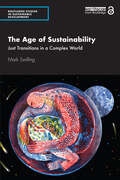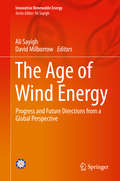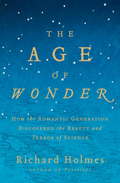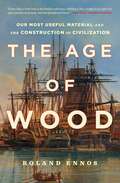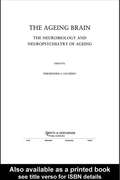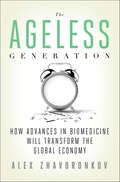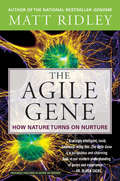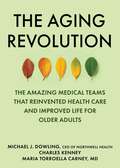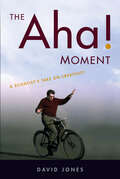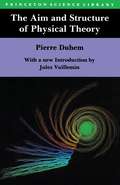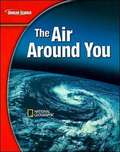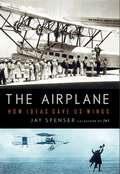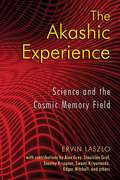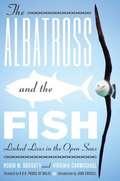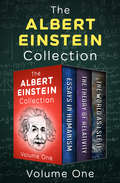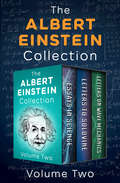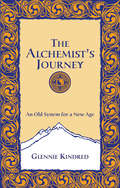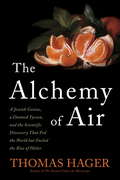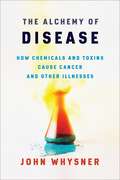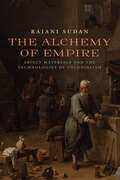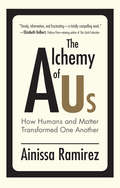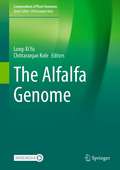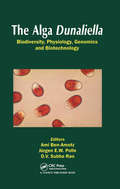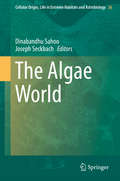- Table View
- List View
The Age of Sustainability: Just Transitions in a Complex World (Routledge Studies in Sustainable Development)
by Mark SwillingWith transitions to more sustainable ways of living already underway, this book examines how we understand the underlying dynamics of the transitions that are unfolding. Without this understanding, we enter the future in a state of informed bewilderment. Every day we are bombarded by reports about ecosystem breakdown, social conflict, economic stagnation and a crisis of identity. There is mounting evidence that deeper transitions are underway that suggest we may be entering another period of great transformation equal in significance to the agricultural revolution some 13,000 years ago or the Industrial Revolution 250 years ago. This book helps readers make sense of our global crisis and the dynamics of transition that could result in a shift from the industrial epoch that we live in now to a more sustainable and equitable age. The global renewable energy transition that is already underway holds the key to the wider just transition. However, the evolutionary potential of the present also manifests in the mushrooming of ecocultures, new urban visions, sustainability-oriented developmental states and new ways of learning and researching. Shedding light on the highly complex challenge of a sustainable and just transition, this book is essential reading for anyone concerned with establishing a more sustainable and equitable world. Ultimately, this is a book about hope but without easy answers.
The Age of Wind Energy: Progress and Future Directions from a Global Perspective (Innovative Renewable Energy)
by Ali Sayigh David MilborrowThis unique volume on wind energy features contributions from the world’s leading research and development pioneers in the field of renewable energy. It discusses advances in offshore wind technology, grid-connected systems, grid stabilization and wind turbine design and highlights. Written from an international perspective, chapters focus on the status of wind energy in various regions and countries across the globe, outlining the positive impact its implementation has had on delaying the catastrophic effects of climate change.
The Age of Wonder: How the Romantic Generation Discovered the Beauty and Terror of Science
by Richard HolmesThe Age of Wonder is a colorful and utterly absorbing history of the men and women whose discoveries and inventions at the end of the eighteenth century gave birth to the Romantic Age of Science. When young Joseph Banks stepped onto a Tahitian beach in 1769, he hoped to discover Paradise. Inspired by the scientific ferment sweeping through Britain, the botanist had sailed with Captain Cook in search of new worlds. Other voyages of discovery—astronomical, chemical, poetical, philosophical—swiftly follow in Richard Holmes's thrilling evocation of the second scientific revolution. Through the lives of William Herschel and his sister Caroline, who forever changed the public conception of the solar system; of Humphry Davy, whose near-suicidal gas experiments revolutionized chemistry; and of the great Romantic writers, from Mary Shelley to Coleridge and Keats, who were inspired by the scientific breakthroughs of their day, Holmes brings to life the era in which we first realized both the awe-inspiring and the frightening possibilities of science—an era whose consequences are with us still.BONUS MATERIAL: This ebook edition includes an excerpt from Richard Holmes's Falling Upwards.
The Age of Wood: Our Most Useful Material and the Construction of Civilization
by Roland EnnosA &“smart and surprising&” (Booklist) &“expansive history&” (Publishers Weekly) detailing the role that wood and trees have played in our global ecosystem—including human evolution and the rise and fall of empires—in the bestselling tradition of Yuval Harari&’s Sapiens and Mark Kurlansky&’s Salt.As the dominant species on Earth, humans have made astonishing progress since our ancestors came down from the trees. But how did the descendants of small primates manage to walk upright, become top predators, and populate the world? How were humans able to develop civilizations and produce a globalized economy? Now, in The Age of Wood, Roland Ennos shows for the first time that the key to our success has been our relationship with wood. &“A lively history of biology, mechanics, and culture that stretches back 60 million years&” (Nature) The Age of Wood reinterprets human history and shows how our ability to exploit wood&’s unique properties has profoundly shaped our bodies and minds, societies, and lives. Ennos takes us on a sweeping journey from Southeast Asia and West Africa where great apes swing among the trees, build nests, and fashion tools; to East Africa where hunter gatherers collected their food; to the structural design of wooden temples in China and Japan; and to Northern England, where archaeologists trace how coal enabled humans to build an industrial world. Addressing the effects of industrialization—including the use of fossil fuels and other energy-intensive materials to replace timber—The Age of Wood not only shows the essential role that trees play in the history and evolution of human existence, but also argues that for the benefit of our planet we must return to more traditional ways of growing, using, and understanding trees. A brilliant blend of recent research and existing scientific knowledge, this is an &“excellent, thorough history in an age of our increasingly fraught relationships with natural resources&” (Kirkus Reviews, starred review).
The Ageing Brain
by Prof Lawrence WhalleyHow and why our brains age, and what we can do to prevent brain ageing and mental deterioration.We joke about growing old. From the viewpoint of youth, old age holds few if any rewards - at best those of increased dignity and wisdom. But as Lawrence Whalley shows in this fascinating overview of the ageing brain, we now have cause to be optimistic about old age.In surveying the prospects of slowing or even preventing the worst effects of brain ageing, Whalley looks at the development of the brain and how this is influenced by environmental factors such as diet and stress; the biological and psychological mechanisms of brain injury and disease, and the range of possible treatments and preventatives; individual differences in brain ageing, and the relative roles of nature and nurture in determining our mental abilities.
The Ageing Brain (Studies on Neuropsychology, Development, and Cognition)
by Perminder S. SachdevWhen confronted with a neurological or psychiatric disorder in an elderly individual, a clinician or researcher is likely to ask how the processes of ageing have influenced the aetiology and presentation of the disorder, and will impact on its efficient management. There are many urban myths about ageing, and some of these apply to the brain. The r
The Ageless Generation: How Advances in Biomedicine Will Transform the Global Economy
by Alex ZhavoronkovOver the past 20 years, the biomedical research community has been delivering hundreds of breakthroughs expected to extend human lifespan beyond thresholds imaginable today. However, much of this research has not yet been adopted into clinical practice, nor has it been widely publicized. Biomedicine will transform our society forever by allowing people to live longer and to continue working and contributing financially to the economy longer, rather than entering into retirement and draining the economy through pensions and senior healthcare. Old age will become a concept of the past, breakthroughs in regenerative medicine will continue, and an unprecedented boom to the global economy, with an influx of older able-bodied workers and consumers, will be a reality. A leading expert in aging research, author Alex Zhavoronkov provides a helicopter view on the progress science has already made, from repairing tissue damage to growing functional organs from a single cell, and illuminates the possibilities that the scientific and medical community will soon make into realities. The Ageless Generation is an engaging work that causes us to rethink our ideas of age and ability in the modern world.
The Agile Gene: How Nature Turns on Nurture
by Matt RidleyArmed with extraordinary new discoveries about our genes, acclaimed science writer Matt Ridley turns his attention to the nature-versus-nurture debate in a thoughtful book about the roots of human behavior.Ridley recounts the hundred years' war between the partisans of nature and nurture to explain how this paradoxical creature, the human being, can be simultaneously free-willed and motivated by instinct and culture. With the decoding of the human genome, we now know that genes not only predetermine the broad structure of the brain, they also absorb formative experiences, react to social cues, and even run memory. They are consequences as well as causes of the will.
The Aging Revolution: The History of Geriatric Health Care and What Really Matters to Older Adults
by Charles Kenney Michael J. Dowling Maria Torroella CarneyA history of aging in the United States and an innovative blueprint for revolutionizing care for older adults from Northwell Health, New York&’s largest health care system. The New York Times described Dr. Robert Butler as &“the man who saw old age anew.&” In his 1975 book Why Survive: Being Old in America, Butler argued that for far too many people old age was &“a period of quiet despair . . . and muted rage&” and he set out to mitigate it. Nearly five decades since he penned his book, a devoted band of brilliant physicians and others in the healthcare field have realized at least a portion of Butler&’s dream: to recognize and alleviate suffering among the aging.The Aging Revolution is the story of Butler and his disciples: women and men who saw older distressed adults in hospitals and homes, and worse: being ignored by most of the medical establishment. These revolutionaries could not ignore the suffering, and they set out—individually and collectively—to create entirely new ways of caring for aging adults to ease their suffering and improve their quality and length of life. This revelatory book tells a story never-before told in its entirety, recounting the one of the most significant periods of improvement in American medical history. Readers will learn about pioneering individuals, concepts, and ideas that have improved the lives of millions, including: the women who placed the spotlight on delirium and falls—major issues for older adults; the campaign to build and spread Geriatric and Palliative Care; the small bands of doctors who worked the halls of Congress to create a new program that provides primary care along with home visits from healthcare professionals; and the New York-based foundation that has devoted its mission and millions exclusively to improving care and quality of life for aging adults. Today, as a result, chronic conditions that almost always accompany old age are far more manageable. Older people enjoy more options for work and professional development, for education, for leisure and travel, for sports and maintaining physical strength and mobility. For increasing numbers of Americans, life is healthier and richer in the experiences that matter most. Yet, aging in America can still be a challenge and, too often, particularly for the poor, a painful struggle. The range of mental and physical well-being has almost infinite variations: ninety-year-olds running marathons; sixty-five-year-olds incapacitated by stroke. While this book celebrates the incredible progress and strides made in this field, it also highlights areas that need improvement. The authors lay out specific steps that, if implemented, could ignite the aging revolution and diminish the total volume of older adults suffering in America.
The Aha! Moment: A Scientist's Take on Creativity
by David JonesThis book is about having ideas and—a much longer haul—making them work. David Jones, best known for his Daedalus column, tells a multitude of stories about creators and their creations, including his own fantastical-seeming contributions to mainstream science such as the unrideable bicycle and chemical gardens in space. His theory of creativity endows each of us with a Random-Ideas Generator, a Censor, and an Observer-Reasoner. Jones applies his theory to a wide range of weird scientific experiments that he has conducted for serious scientific papers, for challenging printed expositions, and for presentations to a TV audience. He even suggests new ones, not yet tried! Creativity is as essential to science as curiosity, physical intuition, and shrewd deduction from well-planned experiments. But, says Jones, ingenuity is very uncertain. Even for the greatest inventors, about 80 percent of ideas fail. Jokiness can help, and so can lots of random data. Jones has plenty of clever advice that will help spark that madly brilliant private thought in the first place—and will encourage you to take it further.Neither dense nor demanding, The Aha! Moment is engrossing, edifying, and scientifically serious; yet it is lightly written and asks lots of silly questions. As Jones shows, it can often pay to take an absurd idea seriously.
The Aim and Structure of Physical Theory (Princeton Science Library #126)
by Pierre Maurice DuhemThis classic work in the philosophy of physical science is an incisive and readable account of the scientific method. Pierre Duhem was one of the great figures in French science, a devoted teacher, and a distinguished scholar of the history and philosophy of science. This book represents his most mature thought on a wide range of topics.
The Air Around You
by Glencoe Mcgraw-HillDiscover the Flexibility to Teach Science Your Way!. "Glencoe Science: The Air Around You," a module in the Glencoe Science 15 book series, provides students with accurate and comprehensive coverage of middle school National Science Education Standards. Concepts are explained in a clear, concise manner, and are integrated with a wide range of hands-on experiences, critical thinking opportunities, real-world applications, and connections to other sciences and to non-science areas of the curriculum. Co-authored by National Geographic, unparalleled graphics reinforce key concepts. A broad array of print and technology resources help differentiate and accommodate all learners. The modular approach allows you to mix and match books to meet your specific curriculum needs.
The Airplane: How Ideas Gave Us Wings
by Jay SpenserIn this entertaining history of the jetliner, Jay Spenser traces aviation's challenges from the outset, and follows the flow of the simple yet powerful ideas that led us to defy gravity. Here are the pioneers—innovators such as Otto Lilienthal, Igor Sikorsky, Louis Blériot, Hugo Junkers, and Jack Northrop—whose amazing contributions collectively solved the puzzle of flight. Along the way, Spenser demystifies the modern jetliner, examining the airplane from wings to flight controls to fuselages to landing gear, to show how each part came into being and evolved over time. And finally The Airplane addresses the future of aviation, outlining the breathtaking possibilities that await us tomorrow, many miles above the earth.Who were aviation's dreamers, and where did they get their inspiration?How did birds, insects, marine mammals, and fish help us to fly?How did the bicycle beget the airplane, and hot water heaters lead to metal fuselages?Who figured out how to fly without seeing the ground, enabling airline travel in all weather conditions?
The Akashic Experience: Science and the Cosmic Memory Field
by Ervin LaszloFirsthand testimonies by 20 leaders in culture and science of their interactions with the Akashic field • Provides important evidence for the authenticity of nonmaterial contact that human beings have with each other and with the cosmos • Demonstrates that the increasing frequency and intensity of these experiences is evidence of a widespread spiritual resurgence • Includes contributions by Alex Grey, Stanislav Grof, Stanley Krippner, Swami Kriyananda, Edgar Mitchell, and others Knowing or feeling that we are all connected to each other and to the cosmos by more than our eyes and ears is not a new notion but one as old as humanity. Traditional indigenous societies were fully aware of nonmaterial connections and incorporated them into their daily life. The modern world, however, continues to dismiss and even deny these intangible links--taking as real only that which is physically manifest or proved “scientifically.” Consequently our mainstream culture is spiritually impoverished, and the world we live in has become disenchanted. In The Akashic Experience, 20 leading authorities in fields such as psychiatry, physics, philosophy, anthropology, natural healing, near death experience, and spirituality offer firsthand accounts of interactions with a cosmic memory field that can transmit information to people without having to go through the senses. Their experiences with the Akashic field are now validated and supported by evidence from cutting-edge sciences that shows that there is a cosmic memory field that contains all information--past, present, and future. The increasing frequency and intensity of these Akashic experiences are an integral part of a large-scale spiritual resurgence and evolution of human consciousness that is under way today.
The Albatross and the Fish
by Virginia Carmichael Robin W. DoughtyBreeding on remote ocean islands and spending much of its life foraging for food across vast stretches of seemingly empty seas, the albatross remains a legend for most people. And yet, humans are threatening the albatross family to such an extent that it is currently the most threatened bird group in the world. In this extensively researched, highly readable book, Robin W. Doughty and Virginia Carmichael tell the story of a potentially catastrophic extinction that has been interrupted by an unlikely alliance of governments, conservation groups, and fishermen. Doughty and Carmichael authoritatively establish that the albatross's fate is linked to the fate of two of the highest-value table fish, Bluefin Tuna and Patagonian Toothfish, which are threatened by unregulated commercial harvesting. The authors tell us that commercial fishing techniques are annually killing tens of thousands of albatrosses. And the authors explain how the breeding biology of albatrosses makes them unable to replenish their numbers at the rate they are being depleted. Doughty and Carmichael set the albatross's fate in the larger context of threats facing the ocean commons, ranging from industrial overfishing to our habit of dumping chemicals, solid waste, and plastic trash into the open seas. They also highlight the efforts of dedicated individuals, environmental groups, fishery management bodies, and governments who are working for seabird and fish conservation and demonstrate that these efforts can lead to sustainable solutions for the iconic seabirds and the entire ocean ecosystem.
The Albert Einstein Collection Volume One: Essays in Humanism, The Theory of Relativity, and The World As I See It
by Albert EinsteinThree captivating volumes reveal how Einstein viewed both the physical universe and the everyday world in which he lived. A century after his theory of general relativity shook the foundations of the scientific world, Albert Einstein&’s name is still synonymous with genius. This collection is an introduction to one of the world&’s greatest minds.Essays in Humanism Nuclear proliferation, Zionism, and the global economy are just a few of the insightful and surprisingly prescient topics scientist Albert Einstein discusses in this volume of collected essays from between 1931 and 1950. With a clear voice and a thoughtful perspective on the effects of science, economics, and politics in daily life, Einstein&’s essays provide an intriguing view inside the mind of a genius as he addresses the philosophical challenges presented during the turbulence of the Great Depression, World War II, and the dawn of the Cold War.The Theory of Relativity and Other Essays E=mc2 may be Einstein&’s most well-known contribution to modern science. Now, on the one-hundredth anniversary of the theory of general relativity, discover the thought process behind this famous equation. In this collection of his seven most important essays on physics, Einstein guides his reader through the many layers of scientific theory that formed a starting point for his discoveries. By both supporting and refuting the theories and scientific efforts of his predecessors, he reveals the origins and meaning of such significant topics as physics and reality, the fundamentals of theoretical physics, the common language of science, the laws of science and of ethics, and an elementary derivation of the equivalence of mass and energy. This remarkable collection, authorized by the Albert Einstein archives, allows the non-scientist to understand not only the significance of Einstein&’s masterpiece, but also the brilliant mind behind it.The World As I See It Authorized by the Albert Einstein Archives, this is a fascinating collection of observations about life, religion, nationalism, and a host of personal topics that engaged the intellect of one of the world&’s greatest minds. In the aftermath of World War I, Einstein writes about his hopes for the League of Nations, his feelings as a German citizen about the growing anti-Semitism and nationalism of his country, and his opinions about the current affairs of his day. In addition to these political perspectives, The World As I See It reveals the idealistic, spiritual, and witty side of this great intellectual as he approaches topics including &“Good and Evil,&” &“Religion and Science,&” &“Active Pacifism,&” &“Christianity and Judaism,&” and &“Minorities.&” Including letters, speeches, articles and essays written before 1935, this collection offers a complete portrait of Einstein as a humanitarian and as a human being trying to make sense of the changing world around him.This authorized ebook features new introductions by Neil Berger and an illustrated biography of Albert Einstein, which includes rare photos and never-before-seen documents from the Albert Einstein Archives at the Hebrew University of Jerusalem.
The Albert Einstein Collection Volume Two: Essays in Science, Letters to Solovine, and Letters on Wave Mechanics
by Albert EinsteinFrom revealing, personal letters to brilliant essays on the nature of science, these three volumes demonstrate the breadth of Einstein&’s thought. The man who became famous for conceiving of the equation E=mc2 kept his mind sharp through stimulating correspondence and applied his intellectual acuity to a number of important scientific issues. The second volume of the Albert Einstein Collection offers a fascinating window into how he developed his ideas. Essays in Science: In these sixteen essays, written at the height of his intellectual powers, Einstein sets out his views on scientific knowledge, its relationship to human experience, and the underlying principles of any scientific pursuit. He discusses his own work in theoretical physics and its basis in field theory, as well as the many achievements of other scientific thinkers—including Johannes Kepler, Isaac Newton, James Clerk Maxwell, Max Planck, Niels Bohr, and others. Letters to Solovine: This collection of personal letters from Einstein to his longtime friend and translator Maurice Solovine offers a rare glimpse into the evolution of his thought, as well as a revealing portrait of the man himself. Spanning Einstein&’s career and ranging from philosophical discussion to personal gossip, these letters are presented in English translation alongside the German text, with facsimiles of the original letters also included. Letters on Wave Mechanics: In this stirring collection of correspondence, four of the twentieth century&’s greatest minds—H. A. Lorentz, Max Planck, Erwin Schrödinger, and Albert Einstein—discuss, debate, and refine Schrödinger&’s then-nascent theory of wave mechanics. As the physicist Karl Przibram states in his foreword to this edition, &“little needs to be added to the letters; they speak for themselves. Apart from their essential content, they reveal something of the personalities of the four men of genius.&”
The Alchemist’s Journey: An Old System For A New Age
by Glennie KindredIn this account of 12 months in her life, much-loved author Glennie Kindred explores the powerful fusion of alchemy with the eight Celtic festivals, and shows us how to tap in to the natural energy of transformation inherent in the earth's cycles. Full of practical ideas to encourage us to be open to the power of transformation, and written in an inspiring and accessible style, this book brings the ancient alchemical processes into a fresh, clear light. Glennie shows us how each season is an opportunity to develop, adapt, and experience ourselves in a new way. This inspires us to unlock the love that brings healing to ourselves and our relationship to the earth. She reveals how we can find this true alchemical gold and become a powerful force for positive change in the world.
The Alchemy of Air: A Jewish Genius, a Doomed Tycoon, and the Scientific Discovery That Fed the World but Fueled the Rise of Hitler
by Thomas HagerA sweeping history of tragic genius, cutting-edge science, and the discovery that changed billions of lives--including your own.At the dawn of the twentieth century, humanity was facing global disaster. Mass starvation, long predicted for the fast-growing population, was about to become a reality. A call went out to the world's scientists to find a solution. This is the story of the two enormously gifted, fatally flawed men who found it: the brilliant, self-important Fritz Haber and the reclusive, alcoholic Carl Bosch. Together they discovered a way to make bread out of air, built city-sized factories, controlled world markets, and saved millions of lives. Their invention continues to feed us today; without it, more than two billion people would starve.But their epochal triumph came at a price we are still paying. The Haber-Bosch process was also used to make the gunpowder and high explosives that killed millions during the two world wars. Both men were vilified during their lives; both, disillusioned and disgraced, died tragically. Today we face the other unintended consequences of their discovery--massive nitrogen pollution and a growing pandemic of obesity.The Alchemy of Air is the extraordinary, previously untold story of two master scientists who saved the world only to lose everything and of the unforseen results of a discovery that continues to shape our lives in the most fundamental and dramatic of ways.
The Alchemy of Disease: How Chemicals and Toxins Cause Cancer and Other Illnesses
by John WhysnerSince the dawn of the industrial age, we have unleashed a bewildering number of potentially harmful chemicals. But out of this vast array, how do we identify the actual threats? What does it take to prove that a certain chemical causes cancer? How do we translate academic knowledge of the toxic effects of particular substances into understanding real-world health consequences? The science that answers these questions is toxicology.In The Alchemy of Disease, John Whysner offers an accessible and compelling history of toxicology and its key findings. He details the experiments and discoveries that revealed the causal connections between chemical exposures and diseases. Balancing clear accounts of groundbreaking science with human drama and public-policy relevance, Whysner describes key moments in the development of toxicology and their thorny social and political implications. The book features discussions of toxicological problems past and present, including DDT, cigarettes and other carcinogens, lead poisoning, fossil fuels, chemical warfare, pharmaceuticals—including opioids—and the efficacy of animal testing. Offering valuable insight into the science and politics of crucial public-health concerns, The Alchemy of Disease shows that toxicology’s task—pinpointing the chemical cause of an illness—is as compelling as any detective story.
The Alchemy of Empire: Abject Materials and the Technologies of Colonialism
by Rajani SudanNamed 'Top 6' South Asia studies publications of 2016 by the British Association for South Asian StudiesThe Alchemy of Empire unravels the non-European origins of Enlightenment science. Focusing on the abject materials of empire-building, this study traces the genealogies of substances like mud, mortar, ice, and paper, as well as forms of knowledge like inoculation. Showing how East India Company employees deployed the paradigm of alchemy in order to make sense of the new worlds they confronted, Rajani Sudan argues that the Enlightenment was born largely out of Europe’s (and Britain’s) sense of insecurity and inferiority in the early modern world. Plumbing the depths of the imperial archive, Sudan uncovers the history of the British Enlightenment in the literary artifacts of the long eighteenth century, from the correspondence of the East India Company and the papers of the Royal Society to the poetry of Alexander Pope and the novels of Jane Austen.
The Alchemy of Us: How Humans and Matter Transformed One Another (The\mit Press Ser.)
by Ainissa RamirezIn the bestselling tradition of Stuff Matters and The Disappearing Spoon: a clever and engaging look at materials, the innovations they made possible, and how these technologies changed us. In The Alchemy of Us, scientist and science writer Ainissa Ramirez examines eight inventions—clocks, steel rails, copper communication cables, photographic film, light bulbs, hard disks, scientific labware, and silicon chips—and reveals how they shaped the human experience. Ramirez tells the stories of the woman who sold time, the inventor who inspired Edison, and the hotheaded undertaker whose invention pointed the way to the computer. She describes, among other things, how our pursuit of precision in timepieces changed how we sleep; how the railroad helped commercialize Christmas; how the necessary brevity of the telegram influenced Hemingway's writing style; and how a young chemist exposed the use of Polaroid's cameras to create passbooks to track black citizens in apartheid South Africa. These fascinating and inspiring stories offer new perspectives on our relationships with technologies. Ramirez shows not only how materials were shaped by inventors but also how those materials shaped culture, chronicling each invention and its consequences—intended and unintended. Filling in the gaps left by other books about technology, Ramirez showcases little-known inventors—particularly people of color and women—who had a significant impact but whose accomplishments have been hidden by mythmaking, bias, and convention. Doing so, she shows us the power of telling inclusive stories about technology. She also shows that innovation is universal—whether it's splicing beats with two turntables and a microphone or splicing genes with two test tubes and CRISPR.
The Alfalfa Genome (Compendium of Plant Genomes)
by Chittaranjan Kole Long-Xi YuThis book is the first comprehensive compilation of deliberations on whole genome sequencing of the diploid and tetraploid alfalfa genomes including sequence assembly, gene annotation, and comparative genomics with the model legume genome, functional genomics, and genomics of important agronomic characters. Other chapters describe the genetic diversity and germplasm collections of alfalfa, as well as development of genetic markers and genome-wide association and genomic selection for economical important traits, genome editing, genomics, and breeding targets to address current and future needs. Altogether, the book contains about 300 pages over 16 chapters authored by globally reputed experts on the relevant field in this crop. This book is useful to the students, teachers, and scientists in the academia and relevant private companies interested in genetics, breeding, pathology, physiology, molecular genetics and breeding, biotechnology, and structural and functional genomics. The work is also useful to seed and forage industries.
The Alga Dunaliella
by Ami Ben-Amotz Jürgen E.W. Polle D.V. Subba RaoThis volume presents a state-of-the art research in biochemistry, molecular biology and medical application. A glossary of specialized terms is appended. Each chapter is contributed by an expert or group of experts dedicated to increase our understanding of Dunaliella. All the chapters were reviewed internally by their colleagues, editors and external reviewers; this was followed by a final revision. The book provides a balanced multi-disciplinary communication and contributes to our understanding of this unique alga. It is addressed to graduate students and scientists as a summary of current thoughts on Dunaliella.
The Algae World
by Joseph Seckbach Dinabandhu SahooAlgal World has been carefully written and edited with an interdisciplinary appeal and aims to bring all aspects of Algae together in one volume. The 22 chapters are divided into two different parts which have been authored by eminent researchers from across the world. The first part, Biology of Algae, contains 10 chapters dealing with the general characteristics, classification and description of different groups such as Blue Green Algae, Green Algae, Brown Algae, Red Algae, Diatoms, Xanthophyceae, Dinophyceae, etc. In , it has two important chapters covering Algae in Extreme Environments and Life Histories and Growth Forms in Green Algae. The second part, Applied Phycology, contains 12 chapters dealing with the more applied aspects ranging from Algal Biotechnology, Biofuel, Phycoremediation, Bioactive Compounds, Biofertilizer, Fatty Acids, Harmful Algal Blooms, Industrial Applications of Seaweeds, Nanotechnology, Phylogenomics and Algal culture Techniques, etc.
